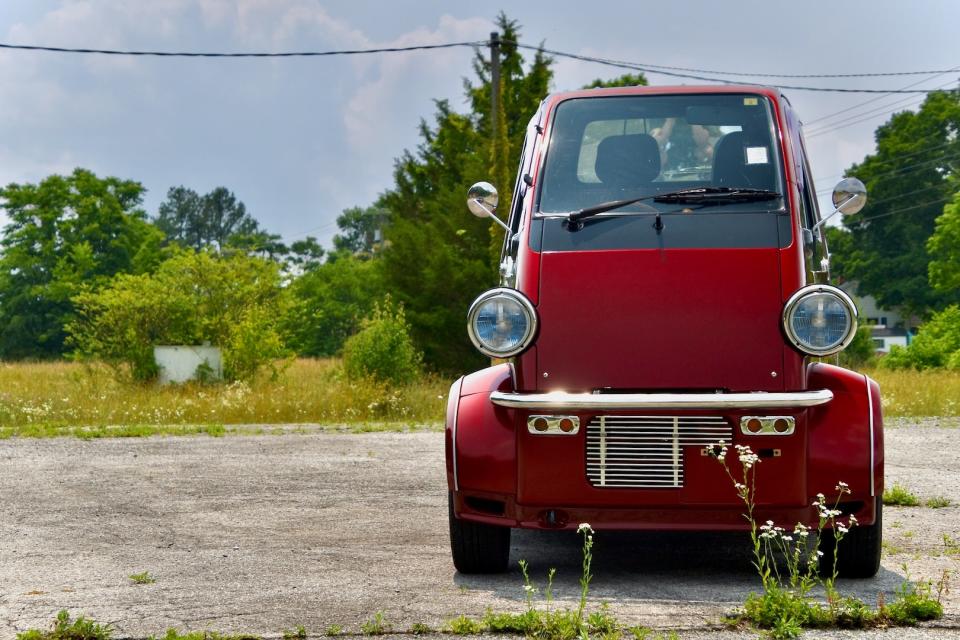1996 Daihatsu Midget II Review: The Antithesis of the American Pickup

The general public doesn’t really care about cars. It’ll perk up if something unusual comes along, though. A rat rod, a DMC DeLorean, a Lamborghini Aventador. All things it understands, and can identify with reasonable Is that a Ferrari? accuracy. A straight-piped dekotora 1997 Daihatsu Midget II, however, is not something the public understands. Americans have no reference point for what it is; they turn their heads and stare, mouths sometimes agape, their expression obvious: “What the hell is that?”
What indeed has a more complicated answer than you might expect. Any truck this… extra has to have an interesting story behind it, and the Midget II does. It’s a callback to one of the trucks that made Daihatsu what it is but also an attempt to make the smallest four-wheeled, highway-legal truck possible. It’s kinda like if the Chevy SSR was a kei truck.

[Editor's Note: JDM Week at The Drive is brought to you by Duncan Imports, one of America's largest importers and resellers of Japanese domestic market vehicles. Big thanks to owner Gary Duncan for opening up his private collection and allowing us to take a few for a spin. If your interest is piqued, you can see the company's full inventory here.]
But removed from the context of 20th-century Japan, it’s unrecognizable as any of those things. All we Americans see is a pickup truck so comically small we could literally park it in the beds of what some gatekeepers consider a “real truck” these days. It’s as much a pickup as it is an anti-pickup—at least, as we define them in the United States in 2023.
In fact, the Daihatsu Midget II is almost diametrically opposed to the American pickup paradigm, and driving one will show you just how grotesque our trucks have become. Kicking and screaming the whole way up to 60 mph, the Midget II isn’t just a slow-motion joyride that’s almost as exciting as it is unnerving. It’s an inflection point that makes you realize it’s time American trucks should scare their own drivers too.

1996 Daihatsu Midget II Specs | |
|---|---|
Just A Little Guy
Explaining what the Daihatsu Midget II is starts by counting backward, to the original Midget. It was essentially a motorized rickshaw, the cheapest self-propelled vehicles that didn't need a kickstand. They arose in Japan in 1931, quickly spread across Southeast Asia and Europe, and remain popular to this day in poorer countries around the globe. Daihatsu didn’t introduce the Midget until 1957, well into Japan’s postwar reconstruction, but its popularity kept it in production ‘til 1972, with the aid of updates and multiple body styles. (Westerners may recognize it from My Neighbor Totoro.)
https://www.youtube.com/watch?v=2IwlaaacrOk\u0026list=PLYYQ_SeN27Q8q2gP-ILAUUcy-WHC-1evJ
Meanwhile, the Midget II is more complicated, both in terms of mechanicals and its place in the world. It takes the original concept, adds a fourth wheel, and rudimentary suspension—MacPherson struts up front, a leaf-sprung solid axle out back. Its engine swelled to 659 cc (as big as kei car engines get), becoming a three-cylinder four-stroke, though it’s still carbureted. It sputters out 31 horsepower and 37 lb-ft of torque for the rear axle, connected by either a four-speed manual or three-speed automatic transmission. The latter switches to a column shifter, freeing up space for a passenger that you’d better be comfortable cuddling.
It weighs only 1,213 pounds though, which allows it to get nearly 60 mpg at 35 mph. It can tote around a payload of 331 pounds too, and its size means there’s no street it can’t drive down—ideal if you run an alleyway bar. Its brakes are drums all around, and a booster wasn’t included at launch. Brake fluid is added through a filler in the dashboard, and there’s no temperature gauge or tachometer. Just a fuel gauge and a 120-km/h speedometer, when most kei cars show 140 (or about 85 mph).






You still get air conditioning and a stereo though; it’s more like a modern car than it is the barebones utility vehicle the original Midget was: It started at the modern equivalent of $3,650. That’s considerably cheaper than name-brand UTVs, and you don’t typically get doors or license plates with those.
The Midget II I drove however wasn’t stock Daihatsu. It’s heavily modified in a fashion I can’t pin down; there are touches of bosozoku with its straight-piped, heart-tipped exhaust, but a body that’s between shakotan and kyusha. It’s also a string of Christmas lights away from being dekotora. I speak beyond my level of knowledge here, as I don’t truly know what to call or make of its body kit, aftermarket wheels with stationary hubs, and fringed window sills. Nor did the public in suburban Virginia where I drove it.


Climbing into the Midget II is easy. Its upright cab allows you to slide onto a seat that amounts to a padded toilet seat lid over the engine. The cabin is so narrow that I could lower both manual windows and adjust both mirrors from the driver’s seat. Its deceptively high seating position and near-vertical hood gives excellent visibility, minus rearward, as your own head blocks much of the rear windows.
The side mirrors also vibrate like a scared chihuahua, intimidated by 659 cc of carbureted lethargy under your rump. It makes the cabin smell like oil when you start it, and its idle noticeably dipped when I turned on the headlights. It wouldn’t move when I first put it into drive, because the pedal box is so tight against the steering column that I hit both by accident (this would be a recurring problem). Also, because I didn’t notice the handbrake was on my right, between the driver’s seat and door.


After releasing it, I crawled onto the road with a three-cylinder, straight-piped drone that only gets louder with speed. It’s so loud, in fact, that I made that note to myself three separate times. That’s what you get with no sound deadening, firewall, or muffler—whoever built this truck straight-piped it. Also, it doesn’t help that you’re forced to floor it to break about 25 mph.
The Daihatsu will do zero to 20 mph just fine, but beyond that, time slows as the Acura RDX behind you bears down, its driver expecting you to surge away like you’ve got three-figure hp. By my timing, zero-to-60 takes 35 (thirty-five) I-shit-you-not,-only-myself seconds. This lack of power and all-around drum brakes present a conundrum when the 50-mph intersection ahead goes yellow. Do I try to gun it through? Or do I slam on the brakes, and hope Breighdyn in his squatted Ram 3500 behind me can see not just the light, but the Midget II stopped at it? (In the end, I made it legally, Breighdyn didn’t.)
https://www.youtube.com/watch?v=sdYwik-8dHU
The weak engine is also a problem when you reach hills because the Midget II’s automatic didn’t seem to know what a downshift was. I slowed from 55 to about 30; I have never been so intimidated by a Ford EcoSport.
This whole time, the Midget II’s narrow track and high driving position made me acutely aware of every minute change in road camber, in a way larger vehicles just never convey. Its short wheelbase, small wheels, and solid rear axle turned every small undulation into a bound over a crest, too. Because the seat is a bench, you slide around it, feeling every motion in your whole body. Even doing the speed limit feels a bit Dakar at times.



I might’ve felt less timid if the steering wheel didn’t have a clunk in it because the Midget II seemed to handle reasonably well. It is pretty light, after all. I bet you could get around a kart track with how tight its turning circle is, too. Tracking one would be an experience—I can scarcely imagine rumbling over the curbs in one. Or, for that matter, racing wheel-to-wheel against several other Midget IIs.
Being at the wheel is only half the delight of driving a Midget II, though. The other half comes from the fact that almost everybody you pass wrenches their neck turning to stare. Keep in mind, I drove this in the vicinity of one of the nation’s biggest sellers of kei trucks; the locals have seen more Honda Actys and Suzuki Carrys than almost anyone outside Japan. And even they couldn’t help but drop what they were doing to watch this tiny, loud, aggressive little pickup that’s about as dangerous as an angry kitten drone away down the road. If you want attention, forget Liberty Walk Lamborghinis: get a Daihatsu Midget II.


What To Know Before Owning
The Daihatsu Midget II’s first and foremost allure is as a novelty. It’s more of one than an actual utility vehicle; other kei trucks overshadow its capabilities, and often at a lower price. That’s to say nothing of the millions of dirt-cheap beater pickups for sale across the nation. It might make sense as a promotional showpiece, or maybe as a motorized food cart, but it’s not good for much more. Maybe a Hayabusa swap, if you have ennui to dispel.
Kept stock though, the Midget II benefits from the parts pool of Daihatsu E-series engines, which were also used in its strong-selling Hijet kei trucks and vans. I’ve also heard of these being upgraded to five-speed manuals, which’d significantly improve their acceleration. It’s worth noting, though, that there are some states where it’s difficult to register kei trucks—it’s a long story involving a rogue industry group and regulatory capture.




Verdict
The Daihatsu Midget II blurs the line between a utility vehicle and a pastiche of one. It’s less a workhorse than a toy, though you could find a productive use if you tried. In that regard, it’s similar to the archetypal American pickup of today: it can be put to work, but statistically speaking, that’s not why most people buy them. To most Americans, a pickup is more about feeling bigger, or safer, or ready for any eventuality.
The Daihatsu Midget II is none of those things, despite still technically being a pickup. It won’t make you feel safe on the road, you won’t have attention to spare for your phone. You’re too focused on not being flattened. Those are the stakes we’ve become insulated from (but not immune to) behind the wheels of immense modern trucks. The Midget II is an extreme that’s almost as far off the mark as the GMC Hummer EV, but it’s just as useful a reference point. Because somewhere in the middle lies the pickup truck of tomorrow, and if it’s at all like the Midget II, it’ll be a riot.

Got a tip or question for the author? You can reach them here: james@thedrive.com

 Yahoo Autos
Yahoo Autos 